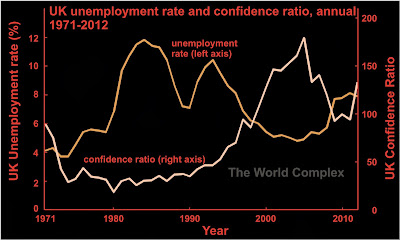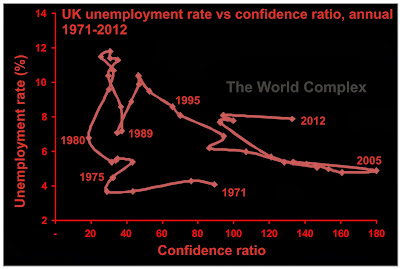The annual New York State Comptroller report on “The Securities Industry in New York City” is traditionally full of relevant information about the state of Wall Street (previously here) from the perspective of the biggest beneficiary of a strong and vibrant Wall Street: the New Your State tax authority which is happy to collect as much taxes on soaring Wall Street bonuses as the law, and IRS audits, will allow. We list the full report highlights below, but the most salient point is the following: in New York City, the average banker made $360,700 in 2012. This is 5.2 more than the average non-financial job in the city (i.e., all other jobs).

The good news: This is one whole turn lower than the peak 6.2x hit in 2007.
The bad news: Twenty-five years ago, this number was 2.0x.
Which is also the reason why a few hundred thousand bankers pray to
Alan Greenspan every night, and sacrifice a filet mignon in gratitude to
both him and the Great Moderation, which allowed this mindboggling run
up to occur in the first place.
More from the report:
The average salary (including bonuses) paid to securities industry employees in New York City grew rapidly from 2003 through 2007, when it peaked at $401,500. The average salary fell sharply in 2009 as the financial crisis deepened, but much of the loss was regained in 2010. Since then, salaries have remained stable, averaging $360,700 in 2012 (see Figure 4). While the 2012 average salary was less than the 2007 peak, it was higher than in any year prior to 2007, and was by far the highest average among the City’s major industries.
The disparity between the average salary in the City’s securities industry and in the rest of the private sector remains wide, even though recently it has narrowed slightly. In 2012, the average salary in the securities industry was 5.2 times greater than the average in the rest of the private sector ($69,200). At its peak in 2007, the average was 6.2 times greater. Twenty-five years ago, the average salary in the industry was twice as high as in other industries.
Yet looking at the actual amount of bonuses paid out one wouldn’t believe that the ratio was as sticky near its all time highs, as it has been. The chart below shows the amount of actual bonus pool by year on Wall Street. Certainly not at the highs that bankers have grown to expect over the past decade:

So how is the per banker comp still so high? Simple: the number of bankers is being slashed at a pace not seen seen the Lehman bankruptcy.

Why is this important:
OSC estimates that each new job created (or lost) in the securities industry leads to the creation (or loss) of two additional jobs in other industries in the City.
The size of the multiplier reflects the high income levels associated with the industry and its importance in the City’s economy. These additional (or fewer) jobs result from Wall Street firms engaging in additional (or fewer) business-to-business transactions (e.g., with professional services firms and other financial firms), and from Wall Street employees increasing (or decreasing) their household spending on such things as restaurants, stores, travel and personal services.
OSC also estimates that each Wall Street job created (or lost) results in one additional (or fewer) job elsewhere in New York State, primarily in the City’s suburbs. Many Wall Street employees are commuters, who live and spend in the suburbs, thereby supporting local businesses and generating jobs.
Translation: less Wall Street jobs, much less NY State (and City) taxes.
Here is what the report had to say on the topic of banker bonuses:
Like most businesses, financial firms report compensation (i.e., base salary, fringe benefits and bonuses, including deferred remuneration) on an accrual basis of accounting. As such, cash bonuses paid in January through March of one calendar year (for work performed during the prior calendar year) are reported in the prior year’s financial statements. For example, most of the resources that are being set aside for cash bonuses in 2013 will be paid out during the first quarter of 2014.
Previously, most bonuses reflected work done in a given year and were paid in cash. This tended to reward short-term profits at the expense of long-term performance. In response to new regulations and other compensation reforms designed to reduce excessive risk-taking, firms have raised base salaries, and now pay a smaller share of bonuses in the current year while a larger share is deferred to future years in the form of cash, stock options or other forms of compensation. Clawback provisions have also been implemented.6 In addition, a greater share of bonuses is now being paid outside the traditional bonus period, making it harder to distinguish bonuses from base salaries.
While these developments have made estimating the size of the cash bonus pool more difficult, they have also reduced volatility in industry tax payments to the State and City. Collections now reflect an average of bonus payments from several years, allowing strong years to offset weak years.
In February 2013, OSC estimated that the cash bonus pool for securities industry workers in New York City paid during the traditional bonus season grew by 8 percent to $20 billion (see Figure 3). The increase in the size of the cash bonus pool reflects a number of developments, including payments received for work done in 2012, when profits were strong, and the realization of bonuses deferred from prior years (including income accelerated into 2012 from future years to avoid the higher federal income tax rates that took effect in 2013).
Total compensation for the broker/dealer operations of member firms of the New York Stock Exchange increased by 5.5 percent during the first half of 2013, and an OSC examination of the financial statements of a sample of large and small firms (including firms that engage in a broader range of activities than traditional broker/dealer operations) also found that compensation was higher than last year.7 These trends suggested that bonuses might be higher in 2013, but recent developments have cast doubt on that outlook. Although it is too early to predict the size of the 2013 bonus pool, bonus awards traditionally vary by firm and by business activity.
Other highlights from the report:
- The average salary in the securities industry in New York City was
$360,700 in 2012. While the 2012 average was less than the 2
007 peak, it
was higher than in any year prior to 2007, and was 5.2 times greater
than the average salary in the rest of the private sector.
- The securities industry had a strong first half of 2013, with broker/dealer profits of $10.1 billion, but profitability is likely to be lower in the second half of the year.
- Despite strong profits over the past four years, the securities industry is smaller in New York City than before the financial crisis. Securities industry employment totaled 163,400 jobs in August 2013, 25,600 fewer (13.5 percent) than before the crisis.
- The securities industry showed strong job growth during the first part of the recovery (adding 9,600 jobs), but since August 2011 it has resumed streamlining and has lost 7,300 jobs.
- New York City has experienced very strong private sector job growth during the recovery, but the securities industry has made only a small contribution (less than 1 percent). In contrast, the industry played a much larger role in employment growth during prior recoveries.
- The securities industry is one of the City’s main economic engines. Even though the industry accounted for only 5 percent of private sector jobs in 2012, it accounted for 22 percent of wages.
- OSC estimates that City tax payments from securities industry-related activities (including capital gains) grew by 27 percent to $3.8 billion last fiscal year, fueled by changes in federal tax rates. This represents the second-highest level on record, and is higher than before the crisis.
- Last fiscal year, securities-related activities accounted for 16 percent of New York State’s tax revenue and 8.5 percent of New York City’s.
- Regulatory reform has proceeded at a slow pace. Less than half (40 percent) of the rules required by the Dodd-Frank Act have been completed, although the industry has begun to modify its practices in anticipation of regulatory changes
Full report can be found here.







via Zero Hedge http://feedproxy.google.com/~r/zerohedge/feed/~3/SILhmp5EQss/story01.htm Tyler Durden











![]()


















